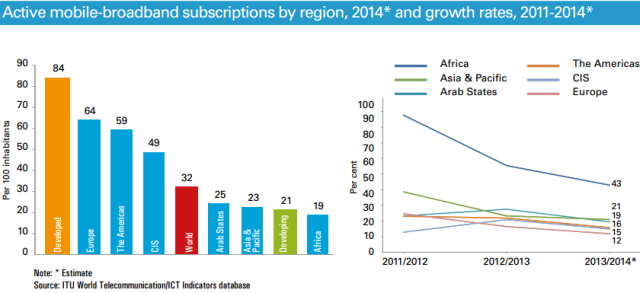In the African context, focus on mobile broadband instead of just “home access”
Many Eurocentric studies of Internet habits focus on home access. In the most developed countries, Internet access at the home, often via desktop or laptop, is extremely common. Moreover, most Internet users in these well-off nations own multiple devices. Those who attempt to examine home Internet access outside of the African context, however, fail to accurately capture millions of mobile devices that are used to access the Internet.
Back in 2011, Gallup asked the question “Does your home have access to the Internet?” to a least 1,000 people each living in one of 148 nations. While the largest economies boasted greater than an 80% home access rate, fewer than 1-in-10 Africans said they had home Internet access. And that number is hazy given the question whether a person interpreted a mobile as constituting “home” access.
At that time, researchers were wise to point out how mobile phones were filling the connectivity void and would continue to do so in the coming years. They were correct. For example, just recently, ITU released an estimate that 19% of Africans have an active mobile broadband subscription. For a few reasons, this number varies by nation and by locale but it is certainly much higher than household access estimates, which the ITU still only puts at 11% (not much changed since the Gallup poll in 2011). In other words, stop focusing on African “home access” statistics and start focusing more on mobile broadband numbers.
Speaking of which, Gallup survey results speak to the impact mobile services are having across SSA. The survey does not focus on broadband, but it does get a great sense general mobile ownership trends in Sub-Saharan Africa.
- Nearly two-thirds (65%) of households in 23 countries in sub-Saharan Africa had at least one mobile phone in 2013
- In countries such as Zimbabwe, growth has far outpaced the average, rising from 26% of households in 2008 to 80% in 2013
- Sub-Saharan Africa is the second-largest mobile technology market after Asia and the fastest growing one
- The growth in mobile phone ownership in sub-Saharan Africa has not been equally distributed across the subcontinent or even within countries
- In 2013, 80% of urban households had at least one mobile phone, compared with 63% of rural households that have at least one mobile phone
- A majority in even the poorest 20% of the population report having at least one phone in their household
- The annual household growth in mobile phone ownership slightly outgrew annual household income in 22 of the 23 countries where growth was measured (4% vs. 5%)
As Gallup finds, “with mobile phone penetration in 2013 lower in rural areas and lowest among households with lower household incomes, there is definitely room for growth in the sub-Saharan Africa market.” Factors impeding the growth of mobile ownership will be inadequate investment in infrastructure and poor policies that fail to help consumers enjoy lower access costs.













 Twitter
Twitter Facebook
Facebook Pinterest
Pinterest